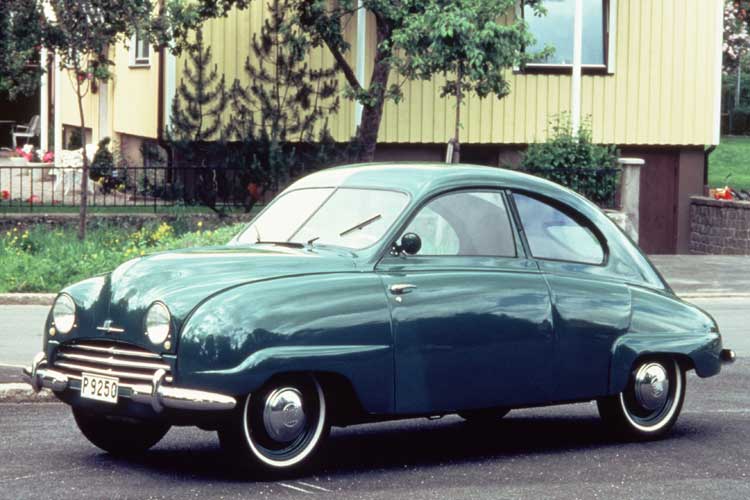Saab 92
As slick as the Saab is today, the company's first car, back in 1945, was a quirky little number designed to be Sweden's VW, writes Brian Sewell

What is a Saab? The car that now locks horns with Audi, Honda, Mercedes and the lesser Jaguar in terms of engine size, price, performance, wood, leather and stylistic anonymity was once as quirky as a baby Citroën or Penhard, designed to be the cheap Volkswagen of Sweden.
In 1945, with the end of the Second World War, Saab, a firm that until then had made planes for the Swedish air force, had to branch out. The designers thought of a Swedish car for Swedes in much the same sense as Citroën thought of the Deux Chevaux for the French peasant, and with more luck and intuition than money for development, devised a vehicle that slotted neatly below Volvo's smallest car. In the code numbers for their planes they had reached 91; the code number for their first car was, therefore, 92.
Designer Sixten Sason's "Project Small Car" - how unromantic Swedes can be - was to have front-wheel drive, leaving an uncluttered cabin with a flat floor for five passengers and luggage. Construction was to be chassis-less, monocoque, and on aerodynamic aircraft principles, the parts tough, reliable and cheap.
Their prime concern seems to have been with the body - the first prototype, 92001, took six months to build in 1946, using wind- tunnel testing "to minimise fuel consumption and the need for power", but according to Saab's archivists, the mechanical components came from scrapyards. It was teardrop shaped, with all four wheels enclosed and a low wide front, the roof and wings sloping to unite elegantly in the tail, the stylistic thinking both French and Middle-European of the later Thirties.
Welded from overlapping steel pressings, it was extremely strong, but its aerodynamic efficiency was slightly spoiled by the flat glass of the windows and split screen. However, the split rear window, larger than that of the original Volkswagen, suited the rear slope handsomely.
This unique shell has much to be said for it in terms of shape, form and even charm, but Saab itself damned it as neither attractive nor practical, and set to work on a revision. A year later, in June 1947, prototype 92002 was ready for the press, essentially the same teardrop shape but with its nose and front wings raised to give it an uglier, American line. The wheels remained enclosed, but the wings were given vestigial bulges, slightly cut away to make them more accessible; the wings themselves became mud traps in the Swedish spring thaws that used to turn the country into a quagmire.
The two doors were hinged at the B-post, and luggage could only be stowed in the car's tail by swinging the back of the rear seat forward. Rear headroom was cramped, rear visibility appalling. The only colour available was a dull bottle-green. It was much the same size and weight as a Ford Prefect, but it was a very different creature from the British family saloon.
All four wheels were independently sprung, the front pair driven by a transverse engine mounted ahead of them. This was of only two cylinders of almost equal bore and stroke, its capacity 764cc (the Ford's was 1,172cc), producing 24bhp at 3,800 rpm. A two-stroke, requiring oil with every gallon of petrol, its exhaust was a pretty glaucous blue, the smell intoxicating.
Based on a pre-war DKW, it should have been reliable but, as one commentator observed, "it gave Saab engineers insoluble headaches when they tried to improve its durability in the hands of careless owners". In terms of performance, drivers at once began to think of the 92 as a sports car that could be driven for long distances at near its maximum speed of 72 mph, and by 1949, it was the car with which to rally in Scandinavia. In 1950, off it went to Monte Carlo.
Yet this was a car with only three gears, giving only 13mph per 1,000 rpm in top. No wonder they gave it a freewheeling mechanism that, on occasion, allowed momentum to replace revs. The rally driver Erik Carlsson made the car famous, driving with right foot hard on the accelerator, left on the brake, his gear changes clutchless, his sharp steering achieved by throwing the rear end into a skid. The worst criticism in its day was that drivers caught their trouser turn-ups on the handbrake.
Gaining only a boot lid and a choice of colour in 1953, the 92 stayed in production until 1955, when the 93 was introduced - virtually the same body but the engine, still a two-stroke, then of three cylinders and 748cc, smoother, quieter, faster. In 1960, this was increased to 841cc. In 1961, a German Ford V-4 engine of 1,500cc was installed, and this, the car's final manifestation, bringing it from type 92 to 96, faded away in 1979, unable to beat the challenge of a Capri 1600.
Any car as odd and idiosyncratic as the little Saab deserves a passionate following, and it has it among aesthetes who praise the purity of the design, and rheumy-eyed old drivers who muse dreamily of its performance as though recalling the wildest women of their lives. Of the variants, none deserves our affection more than the original, the 92 in bottle-green, sans boot lid, of which some 10,000 were produced.
This must surely be the answer to my opening question - a true Saab is not an Opel aping a Mercedes. It's an eccentric oddball of rare and engaging character.
Subscribe to Independent Premium to bookmark this article
Want to bookmark your favourite articles and stories to read or reference later? Start your Independent Premium subscription today.

Join our commenting forum
Join thought-provoking conversations, follow other Independent readers and see their replies